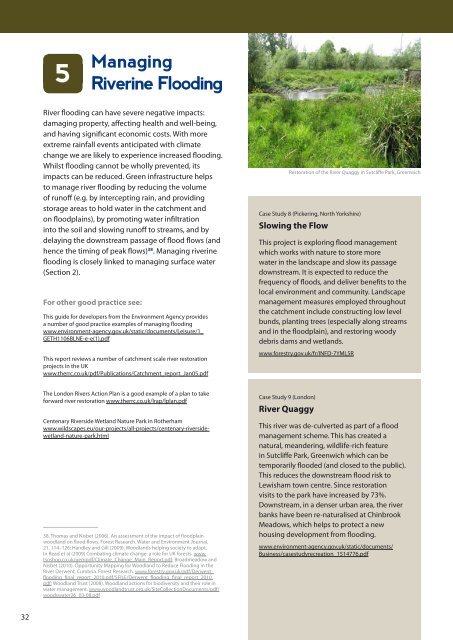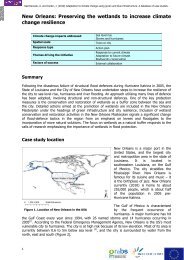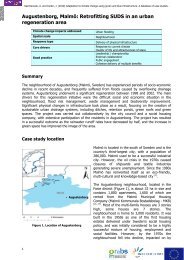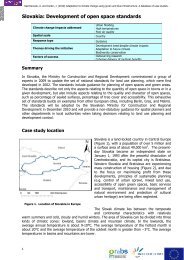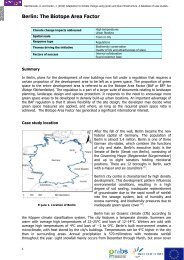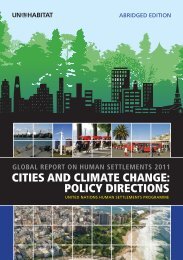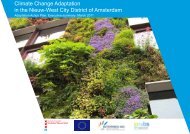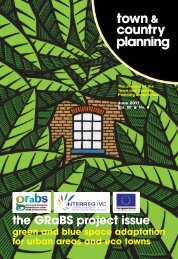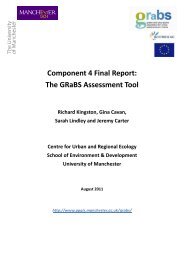Green Infrastructure to Combat Climate Change: A Framework for ...
Green Infrastructure to Combat Climate Change: A Framework for ...
Green Infrastructure to Combat Climate Change: A Framework for ...
Create successful ePaper yourself
Turn your PDF publications into a flip-book with our unique Google optimized e-Paper software.
5 Managing<br />
Riverine Flooding<br />
River flooding can have severe negative impacts:<br />
damaging property, affecting health and well-being,<br />
and having significant economic costs. With more<br />
extreme rainfall events anticipated with climate<br />
change we are likely <strong>to</strong> experience increased flooding.<br />
Whilst flooding cannot be wholly prevented, its<br />
impacts can be reduced. <strong>Green</strong> infrastructure helps<br />
<strong>to</strong> manage river flooding by reducing the volume<br />
of runoff (e.g. by intercepting rain, and providing<br />
s<strong>to</strong>rage areas <strong>to</strong> hold water in the catchment and<br />
on floodplains), by promoting water infiltration<br />
in<strong>to</strong> the soil and slowing runoff <strong>to</strong> streams, and by<br />
delaying the downstream passage of flood flows (and<br />
hence the timing of peak flows) 38 . Managing riverine<br />
flooding is closely linked <strong>to</strong> managing surface water<br />
(Section 2).<br />
For other good practice see:<br />
This guide <strong>for</strong> developers from the Environment Agency provides<br />
a number of good practice examples of managing flooding<br />
www.environment-agency.gov.uk/static/documents/Leisure/1_<br />
GETH1106BLNE-e-e(1).pdf<br />
This report reviews a number of catchment scale river res<strong>to</strong>ration<br />
projects in the UK<br />
www.therrc.co.uk/pdf/Publications/Catchment_report_Jan05.pdf<br />
Res<strong>to</strong>ration of the River Quaggy in Sutcliffe Park, <strong>Green</strong>wich<br />
Case Study 8 (Pickering, North Yorkshire)<br />
Slowing the Flow<br />
This project is exploring flood management<br />
which works with nature <strong>to</strong> s<strong>to</strong>re more<br />
water in the landscape and slow its passage<br />
downstream. It is expected <strong>to</strong> reduce the<br />
frequency of floods, and deliver benefits <strong>to</strong> the<br />
local environment and community. Landscape<br />
management measures employed throughout<br />
the catchment include constructing low level<br />
bunds, planting trees (especially along streams<br />
and in the floodplain), and res<strong>to</strong>ring woody<br />
debris dams and wetlands.<br />
www.<strong>for</strong>estry.gov.uk/fr/INFD-7YML5R<br />
The London Rivers Action Plan is a good example of a plan <strong>to</strong> take<br />
<strong>for</strong>ward river res<strong>to</strong>ration www.therrc.co.uk/lrap/lplan.pdf<br />
Centenary Riverside Wetland Nature Park in Rotherham<br />
www.wildscapes.eu/our-projects/all-projects/centenary-riversidewetland-nature-park.html<br />
38. Thomas and Nisbet (2006). An assessment of the impact of floodplain<br />
woodland on flood flows. Forest Research. Water and Environment Journal.<br />
21, 114–126; Handley and Gill (2009). Woodlands helping society <strong>to</strong> adapt.<br />
In Read et al (2009) <strong>Combat</strong>ing climate change: a role <strong>for</strong> UK <strong>for</strong>ests. www.<br />
tsoshop.co.uk/gempdf/<strong>Climate</strong>_<strong>Change</strong>_Main_Report.pdf; Broadmeadow and<br />
Nisbet (2010). Opportunity Mapping <strong>for</strong> Woodland <strong>to</strong> Reduce Flooding in the<br />
River Derwent, Cumbria. Forest Research. www.<strong>for</strong>estry.gov.uk/pdf/Derwent_<br />
flooding_final_report_2010.pdf/$FILE/Derwent_flooding_final_report_2010.<br />
pdf; Woodland Trust (2008). Woodland actions <strong>for</strong> biodiversity and their role in<br />
water management. www.woodlandtrust.org.uk/SiteCollectionDocuments/pdf/<br />
woodswater26_03-08.pdf<br />
Case Study 9 (London)<br />
River Quaggy<br />
This river was de-culverted as part of a flood<br />
management scheme. This has created a<br />
natural, meandering, wildlife-rich feature<br />
in Sutcliffe Park, <strong>Green</strong>wich which can be<br />
temporarily flooded (and closed <strong>to</strong> the public).<br />
This reduces the downstream flood risk <strong>to</strong><br />
Lewisham <strong>to</strong>wn centre. Since res<strong>to</strong>ration<br />
visits <strong>to</strong> the park have increased by 73%.<br />
Downstream, in a denser urban area, the river<br />
banks have been re-naturalised at Chinbrook<br />
Meadows, which helps <strong>to</strong> protect a new<br />
housing development from flooding.<br />
www.environment-agency.gov.uk/static/documents/<br />
Business/casestudyrecreation_1514776.pdf<br />
32


